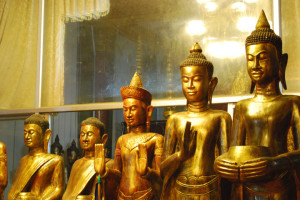A few facts from the Buddhism course I had taken a year ago feebly floated around my mind as my friends and I walked around the Ounalom Pagoda in Phnom Penh, but the lessons I had once concretized were too flimsy to capture and explain the religion and its symbols to my curious friends. Lacking the history, we only walked around and took in the warmth of the room. We lingered just outside the doors of the pagoda trying to decide what our next move would be when suddenly we heard a cheerful voice ask, “Where are you from?”
We turn in the direction of the inquiry and find a monk leaning back in his chair, his orange cloak still vibrant in the growing dusk and a smile just as beaming. “America,” came our standard answer, followed by our specific states. But instead of leaving the conversation there, we grew bold, and asked this monk the questions that had been brewing in our minds in the pagoda.
He told us the answers, but what he shared next with us was far more captivating.
His story began under a mango tree. There, he and 107 other children went to school. With only sticks in their hands and the ground as their paper, they scratched down notes as their teacher, a sixty-something man, taught them basic math and letters. This continued for some time until the students were old enough to take the exam to get into secondary school. But there was a problem: the village could only afford to buy test booklets and pencils for ten students. Only ten students out of 108 could continue their education. Sareth happened to be one of the lucky few, and after they had passed their exams, all ten of the students eagerly began at their new school. But the road did not become easier. With the closest secondary school 17 kilometers away and lacking any means of transport other than the feet given to them, these ten students had to wake as early as five in the morning and trek to their classes, spend the day learning, and then make the journey back home, often with only one meal in their bellies. Soon the students became victim to the struggles of living in rural Cambodia, having to choose to stay home and work over 34 kilometers of walking towards education. Only Sareth remained dedicated to his lessons.
By the time he reached 14 years old, Sareth had to abandon his studies, but for a purpose just as worthwhile. The teacher under the mango tree that had first opened Sareth’s eyes to learning had passed away, leaving the children of his village without an educator. Sareth, with only half of his secondary years completed, filled the void. He began teaching under that same mango tree, but this time around the number had grown to 128 students, this time including adults and monks. It was the monks that first approached Sareth at this time, having seen the impact he was making on the village children, and pressed him to join the monastery. Sareth hesitated; he would have to move from his family, his mother and his eight siblings who lived in a simply-constructed shack, and take from his mother another person to earn money for the family. He discussed the proposition with his mother, who, as a faithful Buddhist, believed that her son would influence a greater community just like a stone thrown into a pond, and encouraged her son to pursue the sangha.
And so Sareth took his vows that same year. Upon walking into the monastery, Sareth encountered a large tree in the middle of the courtyard. It was a mango tree. There, the monks informed him, he could give his lessons to his students. And he did. Since then, Sareth has been educating children in his village and the surrounding community underneath the leaves of that mango tree, but his passion to make a difference in rural Cambodia led him to open two other schools in nearby villages. He eventually finished his secondary education, and now stays in Phnom Penh four out of seven days of the week to complete his education at Wat Ounalom. The other three days he spends in his schools, working with volunteers and students alike to educate and feed those who, like Sareth, began with nothing.
Night had definitely fallen by the time Sareth finished his story. We sat there with him awestruck. For someone who has complained that my classrooms don’t have projectors in them, I was certainly humbled and moved by Sareth’s story. It’s moments like these that give you so much perspective, not only on your life but the lives of others. If only we could experience them every day…
My name is Erin D’Amelio and I’m going to Malaysia for ten months as a Fulbright English Teaching Assistant. Over the next 10 months I will be submitting regular journal entries of this incredible adventure, documenting my thoughts and experiences. The views and beliefs I will present in these articles are my own; they do not reflect those of the Fulbright Program or the U.S. Department of State. Below are the articles, in order of publication. Just click on any link and continue the journey with me.
An Unforgettable Journey
How Does One Get a Fulbright, Exactly?
And Then We Wait
Expectations
Sensory Overload
(Almost) Hitting the Ground Running
Barriers
Role-Play
Mercurial Days
Language and Tennis
Appreciation
Reminders
MH-370
Land of the Wholehearted People
A Mighty and Powerful Mango Tree



Spring Break! Malaysia to Laos and Cambodia. 2 stories @LehighHappening http://t.co/ZZEuxD9dmk and http://t.co/Phfa49ihHT